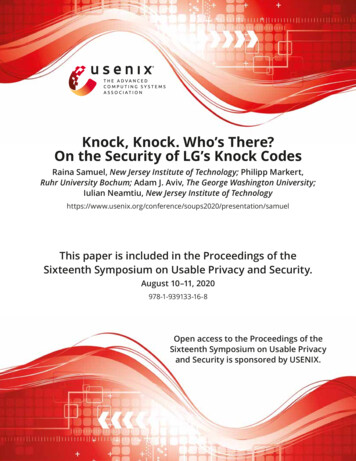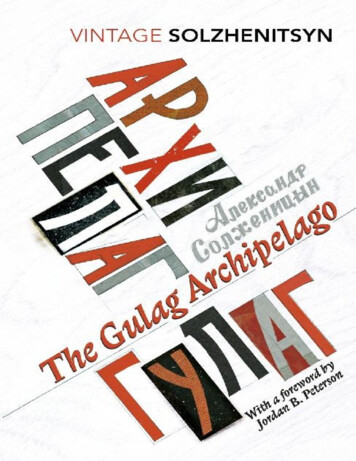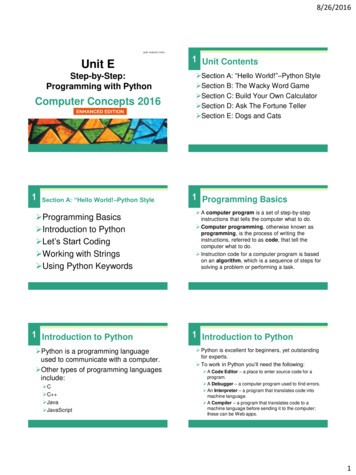
Transcription
Knock, Knock. Who’s There?On the Security of LG’s Knock CodesRaina Samuel, New Jersey Institute of Technology; Philipp Markert,Ruhr University Bochum; Adam J. Aviv, The George Washington University;Iulian Neamtiu, New Jersey Institute of 020/presentation/samuelThis paper is included in the Proceedings of theSixteenth Symposium on Usable Privacy and Security.August 10–11, 2020978-1-939133-16-8Open access to the Proceedings of theSixteenth Symposium on Usable Privacyand Security is sponsored by USENIX.
Knock, Knock. Who’s There? On the Security of LG’s Knock CodesRaina SamuelNew Jersey Institute of TechnologyPhilipp MarkertRuhr University Bochumres9@njit.eduphilipp.markert@rub.deAdam J. AvivThe George Washington UniversityIulian NeamtiuNew Jersey Institute of ock Codes are a knowledge-based unlock authenticationscheme used on LG smartphones where a user enters a codeby tapping or “knocking” a sequence on a 2x2 grid. Whilea lesser-used authentication method, as compared to PINsor Android patterns, there is likely a large number of KnockCode users; we estimate, 700,000–2,500,000 in the US alone.In this paper, we studied Knock Codes security asking participants in an online study to select codes on mobile devicesin three settings: a control treatment, a blocklist treatment,and a treatment with a larger, 2x3 grid. We find that KnockCodes are significantly weaker than other deployed authentication, e.g., PINs or Android patterns. In a simulated attackersetting, 2x3 grids offered no additional security. Blocklisting, on the other hand, was more beneficial, making KnockCodes’ security similar to Android patterns. Participants expressed positive perceptions of Knock Codes, yet usabilitywas challenged. SUS values were “marginal” or “ok” acrosstreatments. Based on these findings, we recommend deployingblocklists for selecting a Knock Code because they improvesecurity but have a limited impact on usability perceptions.1IntroductionMobile device unlock authentication has many variations andthere have been extensive user-based studies on the security ofknowledge-based mobile authentication, including Androidgraphical unlock patterns [4, 47], PINs [10, 38, 50], as wellas using passwords on mobile devices [40]. The conclusionof most of this work is that mobile device users, much likeCopyright is held by the author/owner. Permission to make digital or hardcopies of all or part of this work for personal or classroom use is grantedwithout fee.USENIX Symposium on Usable Privacy and Security (SOUPS) 2020.August 9–11, 2020, Virtual Conference.USENIX Associationwith traditional password selection [18, 28, 39], opt for predictable and easily guessed authenticators. Additionally several physical attacks have been proposed on knowledge-basedmobile authentication, such as smudge attacks [6], sensor attacks [7, 12], vision attacks [51], acoustic signals [52], andshoulder surfing [5, 19, 22].Into this space, LG developed Knock Codes as a new mobileauthentication system that is designed to combat some of theseattacks1 and provide, per LG’s advertising,2 “perfect security.”Knock Codes require a user to recall a pre-selected series ofat least 6 and at most 10 knocks3 (or taps) on a 2 2 quadrantwhich is displayed upon setup and can be entered with thephone screen on or off. Knock Codes are used less frequentlythan PINs or Android patterns, but we estimate that there isa large number of Knock Code users, 700,000–2,500,000 inthe US alone.To evaluate the security and usability of Knock Codes,we conducted two online user studies on Amazon Mechanical Turk: a preliminary study (n 218) and a main study(n 351), analyzing a total of 1,138 Knock Codes (436 inthe preliminary study and 702 in the main study). In themain study, we evaluated three between-group treatments: acontrol treatment, where participants used the current 2x2Knock Code interface; a blocklist treatment, where participants selected 2x2 Knock Codes with some popular codes, asmeasured in the preliminary study, being disallowed; and finally, a big grid treatment, where participants selected KnockCodes on a larger, 2x3 grid.We analyzed the selected Knock Codes across treatmentsand scenarios for security using standard guessing metrics,considering both an offline attacker with unlimited guessesand an online attacker with a limited number of guesses. Wefind that Knock Codes, as currently deployed, offer worsesecurity (51.3 % guessed after 30 attempts) as compared to1 https://youtu.be/0Imk5JILUc0(as accessed on June 11, 2020)(as accessed on June 11, 2020)3 In earlier models, like the 2014 LG G2 [46], where this method firstappeared, codes required at least 3 and at most 8. Newer models require 6 to10 knocks occurring in at least 3 quadrants.2 https://youtu.be/NRInfu-LhncSixteenth Symposium on Usable Privacy and Security37
other widely available unlock authentication schemes, e.g.,4-digit PINs (28.0 %), 6-digit PINs (25.4 %) and Androidunlock patterns (36.6 %).While it seems like a straightforward attempt to increasesecurity, an expanded Knock Code grid to 2x3 does not increase, and sometimes worsens, security as compared to 2x2Knock Codes. After 30 attempts, a simulated attacker correctly guesses more 2x3 Knock Codes compared to 2x2 (41 %vs. 37 %). However, blocklisting common Knock Codes (ascollected in the preliminary study) is more effective at improving guessing security: only 19 % of these codes were guessedwithin 30 attempts in simulation.Overall, participants perceived Knock Codes (across treatments) as secure; however, among all treatments, participantswere more hesitant to rate Knock Codes as more secure thanPINs, Android Unlock Patterns, or alphanumeric passwords.Despite the fact that participants reported Knock Codes as“simple” and “memorable”, responses to the SUS [11] questions averaged to “marginal” or “ok” usability (69.8, 68.1, and64.3, for the control 2x2 treatment, the larger 2x3 treatment,and the blocklist informed 2x2 treatment, respectively). Entryand recall times for Knock Codes were also much slower thanwhat was reported for PINs and Android patterns [27, 38],suggesting lower usability.Based on the survey and analysis, we make the followingcontributions and findings: We conducted a user study of Knock Codes that considers usability and security analysis. We find that Knock Codes, as currently deployed, offer worse security compared to other available methods,both in terms of an online and offline guessing analysis. We evaluated different designs for Knock Codes, findingthat larger grid sizes offer no benefits (and might actually be less secure) while blocklisting offers promise forimproving security. We analyzed both qualitative and quantitative feedbackof the perceptions of security and usability of KnockCodes, finding that while there are some features ofKnock Codes that users like the overall usability was“ok” or “marginal” and the security perceptions wereweak compared to other available schemes.These results indicate that users are interested in new formsof mobile authentication, in particular ones that have optionsfor unlocking with the display off. However, given the usability and security challenges of Knock Codes, we wouldnot recommend further deployment as currently configured.For users and developers who wish to continue to use KnockCodes, we would recommend using a blocklist to inform selection as it provides increased security with small effects onusability.38Sixteenth Symposium on Usable Privacy and Security2Related Work and BackgroundWhile Knock Codes have not been broadly studied in thecommunity, other mobile authentication methods have beeninvestigated widely, namely PINs [16, 20], patterns [4, 44, 47],passwords [29, 35], and biometrics [42], as well as adoptionrates [27] and authentication times [26].Research on user-chosen authentication has shown thatusers tend towards predictable and popular choices, regardlessof the authentication method. For instance, Bonneau et al. [10]studied 4-digit PINs and concluded that while 4-digit PINsfare better in user management and choices, guessing thebirthday is an effective strategy to access a user’s account.Wang et al. showed that 6-digit PINs have marginally bettersecurity than 4-digit PINs, yet both English and Chinese usersfall into certain patterns when choosing PINs [50].Markert et al. collected PINs specifically primed for mobileauthentication and demonstrated that 6-digit PINs offer little(and perhaps worse) benefit than 4-digit PINs against a throttled attacker. Moreover, non-enforcing blocklists (as deployedby iOS) do not increase security [38]. We use an enforcingblocklist in our data collection, as recommend by Markert etal., and compare Knock Codes to the same RockYou [18] andAmitay [1] datasets used by Wang et al. and Markert et al.Patterns, or graphical passwords, have been studied inmultiple contexts, including smudge attacks [6], shouldersurfing [5,19,23,37], and user strength perceptions [2,3]. Theselection process has also been studied [4, 44, 47], and in allcases, users choices are predictable. We compare our resultsto those from Uellenbeck et al. [47] and Aviv et al. [4].There have also been proposals for incorporating moretactile interaction into mobile authentication. For example,Deyle and Roth suggested using “tactile pins” [21]. Kuber etal. [32–34] studied tactile stimuli: a special mouse with a 4x4matrix of PINs for selecting a “tactile password.” Krombholzet al. considered extra touch interactions through pressuresensitive touches on iPhones to enhance PINs [31]. However, these user interaction modalities are very different fromKnock Codes. Similar to Knock Codes, "personal identifiablechords" (PIC) for smartwatches (a multi-touch PIN enteredon a 2x2 grid) have been proposed [41]; these differ in setting(smartwatches) and input type (multi-touch), but the approachcould be used to improve Knock Codes by adding multi-touch.Along with security, usability is an important facet regarding the adoption of authentication methods, thus, quantifyinguser feedback of such methods is pertinent [43]. Regardingbiometric adoption and perceptions, users considered biometrics to be more secure than PINs according to Bhagavatulaet al. [8]. In addition, usability factors (such as poor lightingfor facial recognition) contributed to users’ negative feedbackand reluctance to adopt this method versus a more convenientmethod such as fingerprint recognition. Even with biometrics,this can lead to users choosing weaker forms of knowledgebased authenticators [14].USENIX Association
Detailed description of the survey. The survey consistedof 12 parts as described below. Please see Appendix A forthe exact questions and wording on the pages. We refer tospecific questions within a survey part using the page nameand question number.1. Overview and Informed Consent: Upon starting the survey, participants were informed about the nature of theresearch (per the requirements of our IRB), and providedgeneral instructions for proceedings.Figure 1: Screenshot of a video exploring Knock Codes(https://youtu.be/tPYypLe8LEU) where a user enters aKnock Code with the screen off to unlock the phone. Thiswas used to provide instructions and background informationto users on Knock Codes.3MethodologyWe collected data via Amazon Mechanical Turk (MTurk)using an online survey whereby participants were directedto use their mobile devices (checked via the user-agent) toselect two Knock Codes as well as answer general questionsabout Knock Codes and their demographics. The two KnockCodes were primed based on different security scenarios, asinformed by prior work of Loge et al. [36]. We found some,but minor, differences between Knock Codes in each scenario,similar to Loge et al.’s findings for Android patterns.We conducted two studies: a preliminary study and a mainstudy which is based on the preliminary study and presentedhere. The main difference between the two studies is that themain study was focused on participants using mobile deviceswhile the preliminary allowed participants to use traditionalcomputers. From the preliminary study, we were able to refinethe main study as well as develop a blocklist of the 30 mostcommon Knock Codes selected in the preliminary study (seeTable 3). We provide all study material in the Appendices.Both studies were approved by our institutional review board(IRB).2. Device Usage Questions: Participants reported on thenumber of mobile devices (as defined by a smartphonebut excluding tablet computers and laptops) they own,the brands they use, and which types of mobile authentication they use on those devices. We use this data,normalized to US census data, to estimate Knock Codeusage.3. Instructions: As we could not expect participants to befamiliar with Knock Codes, we provided detailed instructions of Knock Codes. This included a GIF animation ofa user entering a Knock Code (see Figure 1), a displayof the entry screen used later in the survey (see Figure 2), and requirements of Knock Codes (use at least3 different regions and at least 6 total knocks). We alsointroduced the size of the grid, 2x2 for participants whowere assigned to the control or blocklist treatment, and2x3 for the group that tested a larger grid. Those in theblocklist treatment were not informed of the existenceof the blocklist. A detailed description of the treatmentsis given later in this section.4. Practice: After the instructions, participants could practice selecting a sample Knock Code and familiarize themselves with the interface, before proceeding to the actualKnock Code selection. It was clearly stated that this stagewas for practice purposes only. Participants practiced onthe appropriate grid size for their treatment and for thosein the blocklist treatment, there was no blocklist in placeyet, i.e., no indication that a code would or would not beallowed.We found that usage and awareness of Knock Codes arerelatively uncommon. Only 3% of our participants in the mainstudy responded that they use Knock Codes, see Table 2 andonly 1% reported so in our preliminary study. Despite the lowpercentages, this suggests that 700K-2.5M users may deployKnock Codes in the US alone, and we would ideally focus ourstudy just on these users. This is unfortunately not feasible dueto the low concentration on MTurk, and as such, we considera broader set of study participants who may (or may not) beaware of Knock Codes. For those unaware of Knock Codes,our survey would simulate their first experience, as would bethe case if they were selecting Knock Codes for the first timeon a new device.5. Scenario Overview: In addition to a treatment, each participant was assigned to two scenarios under which theywould select Knock Codes for protection. The first ofthe scenarios was always Device Unlock; the other waseither Banking App or Shopping Cart. These scenarioswere adapted from prior work of Loge et al. [36] for collecting Android patterns. Participants were made awareof both scenarios before proceeding and the order inwhich they would be asked to select Knock Codes. Onthis page, we also highlighted that the selected KnockCode will have to be recalled later, hence, participantswere asked to “choose something that is secure and memorable.”USENIX AssociationSixteenth Symposium on Usable Privacy and Security39
10. Recall (2x): Participants were asked to recall their selected Knock Codes. We allowed up to three guessesfor each of the scenarios and forwarded participants ifthey were not able to recall their Knock Code within thislimit.11. Demographic Questions: Participants answered basicdemographic questions about their age, gender, dominant hand, educational background, and technology background. We also included another attention check question on this page.(a) con-2x2 & bl-2x2(b) big-2x3Figure 2: (a) Interface for selecting 2x2 Knock Codes and (b)interface for selecting 2x3 Knock Codes. Both designs mimicthe look and feel of LG’s Knock Code implementation.Figure 3: Blocklist warning display, which mimics blocklistwarnings as used by iOS for PINs.6. Select and Confirm (2x): Participants were promptedto select a Knock Code for the scenario, and confirm itbefore proceeding. The respective pages are shown inFigure 2. Participants of the blocklist treatment saw thewarning message shown in Figure 3 if any selection wasdisallowed. Table 3 contains the list of blocklisted codesas collected in the preliminary study.7. Selection Feedback (2x): After selecting and confirminga Knock Code, participants were asked for feedbackabout their views on the security of their code and anydifficulties in selecting a secure and usable code. Datawas collected in both Likert agreement and through openanswer forms.8. Security Prompts: Now with more familiarity withKnock Codes, participants answered questions about theperceived security of Knock Codes, and also compared itto PINs and Android Unlock Patterns. Participants alsoprovided qualitative feedback on their security likes anddislikes related to Knock Codes in general.9. Usability Prompts: We asked the 10 System UsabilityScale questions [11] related to Knock Codes (plus anattention test).40Sixteenth Symposium on Usable Privacy and Security12. Submission: The survey ended with participants answering an honesty question (i.e., indicated yes/no to “I honestly participated in this survey and followed instructionscompletely.”). Negative responses were removed fromthe results, however, all participants were compensatedfor their work.Treatments. As part of the study, we assigned participantsto one of three treatments. In addition to the standard implementation of LG’s Knock Code, which we refer to as control2x2 or con-2x2 throughout this paper, we tested two additional ones.We first include a blocklist treatment (blocklist informed2x2 or bl-2x2) which differs from the control 2x2 treatmentby the fact that we blocklisted 30 Knock Codes. These codeswere the most frequently used as measured in the preliminarystudy (see Table 3). The blocklist warning, shown in casesof a blocklist hit, is depicted in Figure 3 and is a copy of awarning used by Apple on iOS devices to warn users aboutan insecure PIN choice.We conjecture that by disallowing participants from selecting these common codes, the Knock Codes they eventuallyselect would be stronger (harder to guess). There is a risk withblocklists as they may increase frustration during the selectionprocess by having to perform selection multiple times. But assetting up an authentication method is a one-time event, wewished to understand if blocklists can improve the security ofKnock Codes.As another method for increasing security, we considereda modification to the Knock Code interface. The larger 2x3treatment (big-2x3) uses a 2x3 instead of 2x2 grid and provides participants with more options for creating a KnockCode. Theoretically, this increase makes a substantial difference with 72,520,440 possible 2x3 Knock Codes of length6-to-10, as compared to 1,384,872 2x2 Knock Codes of similar length. The layout is shown in Figure 2b.We decided to use a 2x3 grid rather than a horizontal extension (3x2) or making a square (3x3) because of the formfactor of the phone’s screen, which is taller than it is wide.The 2x3 grid offers a natural extension that fits within theform factor of the screen and mirrors the same interface.USENIX Association
Table 1: Overall demographics of the participants from themain study. Note, zero responses are not shown.251314619207%37 %13 %6%1%0%10643113603%18 %9%3%2%0%1200010%1%0%0%0%0%3619777328110 %56 %22 %9%3%0%Left-handedRight-handedAmbidextrousPrefer not to say31182919%52 %3%0%14103704%29 %2%0%03010%1%0%0%4528816213 %82 %5%0%UrbanSuburbanRuralPrefer not to say919933026 %29 %9%0%445723012 %16 %7%0%01210%0%0%0%13515758138 %45 %17 %0%High SchoolSome fessionalDoctoratePrefer not to say3645822911911010 %13 %3%7%26 %6%0%0%0%62591755101102%7%3%5%16 2112 %20 %6%12 %42 %8%0%0%0%TechnicalNon TechnicalPrefer not to say1021101130 %31 %3%289428%27 %0%2110%0%0%1322051438 %58 %4%Total22364 %12435 %41%351100 %Recruitment. The survey was distributed as an AmazonMechanical Turk task, paying 1.25. On average, it took ourparticipants 8.5 minutes to complete the survey. We ran thesurvey over the course of two days in June 2019. We recruited351 participants, each creating two Knock Codes, for a total of702 selected and confirmed Knock Codes, but also additionalKnock Codes that were not confirmed, either due to memorability or the blocklists. We do not consider the practice KnockCodes in our analysis.The demographics and backgrounds of the participants arelisted in Table 1 and 2. As usual for Amazon Mechanical Turk,the participants tended to be younger and predominantly male,but there was diversity in other categories. A number of ourparticipants reported using Knock Codes on their devices aspart of their authentication choice. As Knock Codes were anew interface to many participants, our design models thescenario where a user acquires and first uses an LG phone toperform the initial Knock Code set-up.Estimating US Knock Code Usage. We generalized ourparticipants’ device usage and authentication methods basedon age and normalized it to the US population using censusdata [48, 49]. We saw that LG’s market share in the US had arange between 8% to 12% among the estimated 285,300,000smartphone users [17, 45]. Using that, as well as a 95% confidence interval, as our lower and upper bounds, we concludeUSENIX AssociationFemale%No.%No. Devices18 2425 3435 4445 5455 64Prefer not to sayMaleNo.One deviceTwo devicesThree devicesFour or more devices1446114441 %18 %4%1%863440Device aneous2326951401157235%6%2%11 %9%25 %1%5%4 digit PIN6 digit PIN6 digit PINAndroid patternKnock CodeFingerprintFacial RecognitionOtherNo Authentication1211912699963301721 %3%2%12 %2%17 %6%0%2%Authentication cationFemaleBackgrnd.MaleNo.Table 2: Answers of the participants from the main studyregarding their device usage.OtherTotalNo.%No.%24 %10 %1%0%21010%0%0%0%2329618566 %28 %5%1%13114261677463%2%1%6%4%17 3%22 %13 %43 %2%6%67105224411412013 791131394713834 %5%3%16 %3%24 %9%0%6%that there are potentially many Knock Code users: 728,693to 2,567,207 in the US alone. We believe, though, that theactual adoption rate is most likely on the lower end. Whilethis may be an optimistic estimate, it still suggests that thereis a substantial number of Knock Code users in the generalpublic, particularly worldwide.Even though Knock Codes are not as widely adopted asother traditional methods of mobile authentication, it is stillimportant to study user behavior with real-world, deployedauthentication systems. In addition, on Google Play manyKnock Code apps can be installed on any Android device, thusnot limiting Knock Codes to solely LG devices. For instance,the most highly rated Knock Code app on Android, “KnockLock,” boasts more than 1 million installations and claimsthat it is an innovative lock screen that “will leave intrudersbaffled” [30]. This app is just one among the plethora ofKnock Code knock-off apps that can be found on GooglePlay, indicating that this authentication method may have ahigher adoption rate and influence on mobile authenticationsystems than appears initially.4LimitationsThere are a number of limitations associated with our methodology and survey design. One such limitation is that the survey’s recall component occurred within a short time framewith minimal distraction tasks. While we can report on shortterm memorability of Knock Codes, we cannot report on thememorability over extended time periods, e.g., days.However, as a mobile unlock authentication method, usersmust recall their codes frequently, hence short-term recallSixteenth Symposium on Usable Privacy and Security41
is still relevant. The increased use of biometrics, which reduces the number of knowledge-based recalls, confounds theissue though, and more research would be needed to betterunderstand long-term memorability of Knock Codes.There are also some limitations on how likely the selectedKnock Codes would be real Knock Codes of real users. Webelieve that the simple interface and the nature of the initialdevice setup suggest that these Knock Codes would be akinto those used on real devices. Most of our participants wereunfamiliar with Knock Codes when taking the survey and sowould be new users of LG devices setting up their Knock Codefor the first time. It should also be noted that a few participantswho do use Knock Codes (both in the preliminary study andmain study) reported that they reused their Knock Code in thesurvey.Nevertheless, we attempted to address this limitation andthus decided to provide different security scenarios for whichparticipants should create Knock Codes. This technique wasused by Loge et al. [36] when collecting Android UnlockPatterns. The motivation is that different scenarios, one alwaysbeing device unlock, will help users to be more careful abouttheir choices, similar to how they may be during device setup.In analyzing the data (Section 6), we did not find significantdifferences between the Knock Codes selected under eachscenario for the bl-2x2 treatment but did see some differencesfor the con-2x2 and larger 2x3 treatment.5Statistics of Knock CodesThe first step in analyzing Knock Codes is to determine thefrequency statistics. Table 4 displays the 30 most frequentpatterns, combined, across the scenarios for three treatmentsof the main study. The frequencies which we observed in thepreliminary study are shown in Table 3. The preliminary studycodes and the con-2x2 codes have a lot of overlap, with 42.0%of the Knock Codes from the preliminary study appearing inthe top-30 most frequent codes in the Control 2x2 treatment.This helps justify using the most frequent preliminary studycodes as the basis of the blocklist for the bl-2x2 treatment.Code frequency. The most common Knock Code in ourcontrol dataset is( f req 6.9 %). Itstarts in the upper left corner, follows a left-to-right sequence,and is repeated until the minimum length of 6 is reached. Weobserve a similar strategy for the code( f req 4.6 %) which is the most frequent one in the larger2x3 treatment. However, participants were able to reach theminimum length without repeating the pattern because of thelarger grid.The second most common Knock Code( f req 3.9 %) in the control 2x2 treatment starts in theupper left quadrant, moving clockwise. In contrast to this,( f req 4.2 %), the second most42Sixteenth Symposium on Usable Privacy and SecurityTable 3: Top 30 most frequent Knock Codes from the preliminary study, which were used as the blocklist in the bl-2x2treatment of the main study.Rank12349111823Knock CodeNo.%2825197777766555555544444333333336.4 %5.7 %4.4 %1.6 %1.6 %1.6 %1.6 %1.6 %1.4 %1.4 %1.1 %1.1 %1.1 %1.1 %1.1 %1.1 %1.1 %0.9 %0.9 %0.9 %0.9 %0.9 %0.7 %0.7 %0.7 %0.7 %0.7 %0.7 %0.7 %0.7 %used code in the larger 2x3 treatment, has different attributes:participants proceed diagonally over the grid, going down in aright-left movement for the first diagonal and up in a left-rightmovement for the second one. The first half of the third mostused Knock Code( f req 3.8 %) isidentical, yet, it differs at the second diagonal which followsa top-down movement instead of bottom-up.The third most used Knock Code in the control 2x2 treatment (, f req 3.5 %) pursues a left-toright sequence again, however, participants used double tapsto comply with the required minimum length of 6 knocks.Participants of the blocklist informed 2x2 treatment usedthis strategy to an even greater extent: the three most usedKnock Codes all contain multiple double taps and 51.0 %of all codes created for this treatment include one or morerepeated taps. In contrast to this, only 41.0 % of the codes inthe control 2x2 treatment and 29.0 % of the codes in the larger2x3 treatment contain at least one repeated tap. Moreover, thedistribution of Knock Codes in the blocklist informed 2x2treatment is more equal compared to the other two. The mostused Knock Code,, occurs in only 2.6 %of the cases and as can be seen in Table 4 the distributionflattens the fastest.USENIX Association
Table 4: Top 30 most frequent Knock Codes in all three treatments.RankAll Control 2x2Knock .9 %3.9 %3.5 %2.6 %2.2 %2.2 %1.7 %1.7 %1.7 %1.7 %1.7 %1.7 %1.3 %1.3 %1.3 %1.3 %1.3 %1.3 %1.3 %1.3 %1.3 %1.3 %0.9 %0.9 %0.9 %0.9 %0.9 %0.9 %0.9 %0.9 %RankAll Blocklist 2x2Knock Code12416No.%6553333333333332222222222222222.6 %2.2 %2.2 %1.3 %1.3 %1.3 %1.3 %1.3 %1.3 %1.3 %1.3 %1.3 %1.3 %1.3 %1.3 %0.9 %0.9 %0.9 %0.9 %0.9 %0.9 %0.9 %0.9 %0.9 %0.9 %0.9 %0.9 %0.9 %0.9 %0.9 %Rank123568111421All Large 2x3Knock CodeNo.%111099876555444333333322222222224.6 %4.2 %3.8 %3.8 %3.4 %2.9 %2.5 %2.1 %2.1 %2.1 %1.7 %1.7 %1.7 %1.3 %1.3 %1.3 %1.3 %1.3 %1.3 %1.3 %0.8 %0.8 %0.8 %0.8 %0.8 %0.8 %0.8 %0.8 %0.8 %0.8 %To summarize, the frequencies of the Knock Codes showdifferent characteristics depending on the assigned treatment,suggesting natural, human tendencies in the selection thatcan be leveraged in predicting and guessing Knock Codes.We take advantage of this observation when guessing codes.Participants in the blocklist informed 2x2 group use morerepeated taps whereas codes created for the 2x3 treatmentmake use of the larger grid and follow directional patterns.Knock Codes created for the control 2x2 depict a mix andfollow both strategies equally.To understand the left/right and up/downshifting of theKnock Codes
Intothis space,LG developedKnockCodes as a newmobile authentication system thatis designedto combatsome ofthese attacks1 and provide, per LG's advertising,2 "perfect security." Knock Codes require a user to recall a pre-selected series of at least 6 and at most 10knocks3 (or taps) on a 2 2 quadrant










